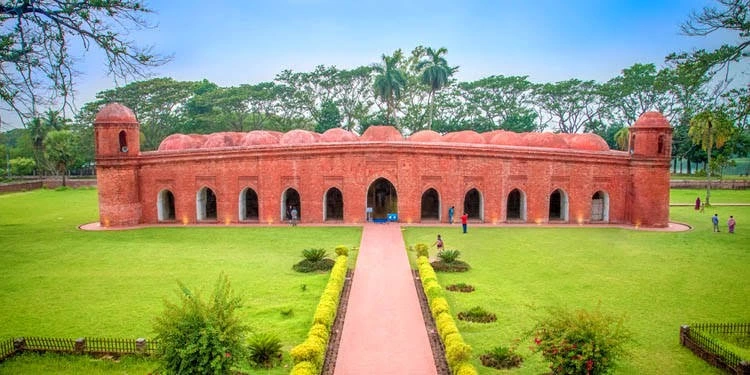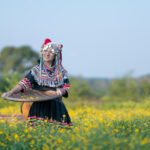If you’ve ever stared up at a Gothic cathedral and wondered what a South Asian answer to stone vaults and flying buttresses might look like, set your compass for the Sixty Dome Mosque in Bagerhat, southwest Bangladesh. Locally called Shat Gombuj Masjid, this low, sprawling domed mosque is the headline monument of the Historic Mosque City of Bagerhat, a UNESCO World Heritage ensemble where red brick, terracotta, and ingenious ventilation combine into a cool, echoing forest of columns and domes.
This in-depth guide is clear travel logistics, culture-savvy tips, ethical photography guidance, and an easy day-trip plan from Khulna. Whether you’re layering Bagerhat into a country-wide itinerary or tacking it on to a Sundarbans cruise, you’ll have everything you need to visit respectfully, comfortably, and confidently.
Fast Facts (Bookmark This)
- What: Sixty Dome Mosque (Shat Gombuj Masjid), centerpiece of UNESCO’s Historic Mosque City of Bagerhat
- Where: Bagerhat District, Khulna Division, Bangladesh (≈ 15–20 miles/25–35 km from Khulna city)
- When Built: 15th century (c. 1440s–1450s)
- By/For: Khan Jahan Ali—Sufi leader, city founder, Bengal Sultanate administrator
- Why famous: Hypnotic grid of 60 stone pillars supporting 77 low domes (plus four on the corners), brick architecture unique to medieval Bengal
- Status: Active place of worship (dress modestly and time your visit around prayer times)
- Pairing: Nine Dome Mosque, Singair Mosque, Khan Jahan Ali’s Mausoleum, Kodla Moth temple; add-on to Sundarbans trip
Why the Sixty Dome Mosque Belongs on Your Shortlist
The Sixty Dome Mosque is not just “a big, old mosque.” It’s a frozen moment from the 1400s, when this part of Bengal was a flourishing frontier of Islamic urban planning. The original city—once called Khalifatabad—was laid out with water tanks, roads, bridges, and religious buildings that served faith and community. Walk inside and you’ll feel it immediately: the temperature drops, sound softens, and your eyes follow colonnades to a repeating pattern of shallow domes. It’s a human-scale, domed mosque that feels both intimate and vast.
“Sixty” domes… but how many are there really?
Travelers often hear a few numbers. Here’s the simplest way to understand it:
- 60 refers to the stone pillars (columns) that carry the roof.
- 77 refers to the main shallow domes overhead in the grid.
- 81 is also cited because there are four additional domes—one on each corner tower.
Different counts emphasize different features; the historical “sixty” label stuck because the forest of pillars is what you feel first.
A Short History: Bagerhat, Khan Jahan Ali, and a City in the Mangroves
In the mid-15th century, Khan Jahan Ali—a Sufi saint, builder, and local governor under the Bengal Sultanate—founded a planned city near the mangrove edges of what we now call the Sundarbans. His vision blended piety and practicality: mosques, roads, bridges, and reservoirs (or dighis) to anchor community life to reliable water, trade, and devotion.
Khalifatabad thrived during his lifetime and slowly slipped into decline after his death in 1459. Over centuries, many structures were swallowed by vegetation and silt. In the modern era, archaeological work and conservation brought the monuments back into view, culminating in UNESCO recognition for the Historic Mosque City of Bagerhat. Today, you’ll find not just one monument but a constellation of sites woven through villages, orchards, ponds, and quiet lanes.
What Makes the Architecture So Special?
Brick First, Everything Else Second
Stone is scarce in much of Bangladesh, so medieval builders leaned into baked brick. The Sixty Dome Mosque showcases this perfectly: thick brick walls, terracotta ornamentation, and dressed stone used where the loads demanded it (columns, lintels, a few details). The result is a warm red palette that glows at golden hour—and feels timeless in soft overcast light.
The Plan: Seven by Eleven
Inside, the hall is organized as seven aisles (north–south) by eleven bays (east–west), creating that mesmerizing grid. Sixty stone columns carry arches and the shallow domes above. The ceiling height is low compared to grand Ottoman or Persian mosques, but the repetition creates a powerful sense of scale.
Air, Light, and Coolth
Even in tropical heat, the interior holds cooler air. Thicker walls, ventilation openings, and the mass of the brick/stone regulate temperature and dampen sound—a natural “AC” 500 years before compressors.
Outside: Subtle Drama
Instead of a towering central dome, the Sixty Dome Mosque uses corner turrets topped with cupolas and gently curved cornices that nod to regional roof traditions. The façade is understated: buttressed walls, arched openings, and a long, low silhouette that suits the delta landscape.
What to See Near the Sixty Dome Mosque (Don’t Miss These)
Bagerhat is often called the “City of Mosques.” Here are the nearby stops that turn your visit into a rich half-day or full day:
- Nine Dome Mosque (Noy Gombuj Masjid): Smaller than its famous cousin but with beautiful proportions. Great stop for quiet photos and architectural contrast.
- Singair Mosque: An elegant, compact mosque that helps you appreciate how architects varied form and ornament at a smaller scale.
- Mausoleum of Khan Jahan Ali: The revered founder’s tomb is a serene complex beside a large pond. You’ll hear local stories—including the famous crocodile pond—while observing pilgrimage practices.
- Kodla Moth (Temple): A 17th-century shikhara-style Hindu temple with terracotta panels—evidence of the multi-faith heritage in greater Bagerhat.
- Bagerhat Museum & Site Remains: If open during your visit, the local museum and scattered archaeological traces (roads, tanks, brickwork) add context to the “city” part of the UNESCO listing.
If you have two or more days, pair Bagerhat with a Sundarbans excursion (mangrove forests, river life, birding) from Mongla or Khulna.
Planning Your Visit (U.S. Traveler Essentials)
Getting There: Dhaka → Khulna → Bagerhat
- Step 1: Dhaka to Khulna
- Flight: The fastest way—look for domestic flights to Jashore (Jessore) then transfer by road (≈ 2–3 hours) to Khulna.
- Rail: Intercity trains connect Dhaka and Khulna; book in advance for air-conditioned classes.
- Road: Long haul by bus or private car is possible; expect full-day travel.
- Step 2: Khulna to Bagerhat
- Private car/driver or guided tour: ≈ 1 hour each way. This is the easiest, most time-efficient option, especially if you want to hit multiple monuments + lunch and get back before dark.
Tip: If you’re short on time, base in Khulna for one night and do Bagerhat as a half-day or day trip.
Best Time of Year
- November–March (Dry/Cool Season): The most comfortable window. Warm days, mild evenings, plenty of sunshine.
- April–May: Hot and humid; go early morning.
- June–September (Monsoon): Lush and atmospheric, but rain can slow travel and limit photography options.
Hours, Access, and Prayer Times
The Sixty Dome Mosque is an active worship site. You can typically visit outside daily prayer times and especially outside the Friday midday prayer when attendance peaks. During prayer, step outside and avoid photographing worshippers. Many travelers plan an early morning or late afternoon visit for softer light and fewer crowds.
Dress Code & Etiquette
- Cover shoulders and knees (men and women).
- Headscarves: Appreciated for women when entering prayer areas.
- Shoes: Remove before stepping into prayer spaces; carry a small bag for your footwear.
- Behavior: Keep voices low, never step in front of someone who is praying, avoid flash and intrusive angles.
Safety & Comfort
Bagerhat is generally calm and welcoming. Bring sun protection, a refillable water bottle, and some cash for site donations, snacks, or tips. Toilets at rural monuments can be basic—plan ahead in Khulna or at select museums/restaurants.
Photography Guide: How to Capture a Domed Mosque Without Being “That Tourist”
Light & Timing
- Exterior: Golden hour (early morning or late afternoon) makes the red brick glow.
- Interior: Late morning can be fantastic—ambient light filters in and the domes render evenly without harsh contrast.
Lenses & Framing
- Wide angle (14–24mm or 16–35mm): To capture the column grid and recessive arches.
- Fast prime (35mm/50mm): For details and respectful portraits with permission.
- Tripods/Monopods: Ask first. A mini tripod or bracing against a column often suffices at low ISO.
Respectful Shots
- Avoid faces during prayer; shoot architectural patterns, hands, calligraphy, tilework, brick joints, and the rhythm of arches instead.
- Don’t touch plaster, carvings, or terracotta panels to “pose” a shot—oils damage surfaces over time.
One Perfect Day: Bagerhat from Khulna
07:30 – Depart Khulna (AC car).
08:30 – Sixty Dome Mosque: Start outside (context shots), then explore the interior grid. Give yourself time to stand still and listen.
10:00 – Nine Dome Mosque and Singair Mosque: Two smaller mosques that reward careful looking and detail photography.
11:30 – Mausoleum of Khan Jahan Ali: Walk the grounds, notice the water management around the dighi (tank).
12:45 – Lunch in Bagerhat or back in Khulna: Try local specialties (ask for Chui Jhal meat curry, seasonal river fish, or vegetarian thalis).
14:30 – (Optional) Kodla Moth for terracotta and shikhara architecture.
16:30 – Return to Khulna; consider a short boat ride on the Rupsha River for sunset.
18:30 – Back at hotel.
Make it effortless: Book a guided day trip with hotel pick-up in Khulna/Bagerhat/Mongla, AC car, English-speaking guide, lunch, site timings handled, and plenty of time for photos. (Ask us to customize a Bagerhat + Sundarbans combo.)
Culture & Etiquette: Small Gestures, Big Impact
- Greetings: A simple smile and a nod go a long way.
- Hands: Use your right hand to offer/receive items.
- Shoes: Off in prayer halls—no exceptions.
- Donations: Modest, voluntary; a pleasant way to say thanks for hospitality.
- Friday: Consider visiting smaller monuments during Friday midday prayers, then the main mosque before/after.
Conservation & Responsible Travel
The red-brick monuments of Bagerhat face real threats—salinity, humidity, bio-growth, and sometimes insensitive repairs. As visitors:
- Stay on paths and avoid leaning on or touching decorative surfaces.
- No litter—pack out what you bring in.
- Buy local—hire local guides, eat at neighborhood restaurants, and purchase crafts responsibly.
- Share respectfully—post images that honor worshippers and the place.
Heritage travel is a privilege. Treat it like one, and it will welcome travelers long after we’re gone.
Where to Base & What to Eat
Base: Khulna works best—broad range of hotels and restaurants, good road links to Bagerhat, and easy onward travel to Mongla for the Sundarbans.
Food:
- Chui Jhal (regional meat curry with a distinctive peppery vine)
- Bhuna and biryani varieties
- Fresh river fish (ask for daily specials)
- Plenty of vegetarian options (dal, vegetable curries, rice, roti)
Water: Stick to sealed bottles in restaurants; bring a reusable bottle to refill at your hotel to reduce plastic waste.
Frequently Asked Questions (FAQs)
1) What is the Sixty Dome Mosque?
It’s a 15th-century domed mosque in Bagerhat, Bangladesh, and the signature monument within UNESCO’s Historic Mosque City of Bagerhat. Its name comes from the grid of 60 stone pillars supporting dozens of shallow domes.
2) How many domes are there?
You’ll hear 60, 77, and 81. The simplest breakdown: 60 pillars support 77 main domes in the roof grid, and there are four additional domes on the corner towers.
3) Is the mosque still active? Can non-Muslims visit?
Yes, it’s an active worship site. Non-Muslims can usually visit outside prayer times. Dress modestly, remove shoes in prayer spaces, and avoid photographing people at prayer.
4) How do I get there from Dhaka?
The smoothest route for U.S. travelers: fly or take the train to Khulna, then go by private car (≈ 1 hour) to Bagerhat. Guided day trips are the most efficient way to cover multiple monuments comfortably.
5) What’s the best time to visit?
November to March offers cooler, drier weather and the best chance of golden-hour light. During monsoon (June–September), expect lush greenery but heavier rain and slower travel.
6) Can I combine Bagerhat with the Sundarbans?
Yes. Many travelers do Bagerhat as a day trip and then spend 1–2 nights on a Sundarbans cruise from Mongla or Khulna.
7) Is photography allowed inside?
Architectural photography is generally fine, but avoid flash, ask before photographing people, and pause during prayer times. When in doubt, gesture your question and wait for a nod.
8) What should I wear?
Cover shoulders and knees (men and women). Women may bring a headscarf for prayer spaces. Slip-on shoes are handy since you’ll remove them frequently.
9) How long do I need at the Sixty Dome Mosque?
Plan 60–90 minutes to explore inside and out calmly, plus time for nearby sites (Nine Dome, Singair, Mausoleum, Kodla Moth) if it’s a full day.
10) Is Bagerhat kid-friendly?
Yes—open spaces, short distances between monuments, and few stairs. Carry water, hats, and snacks, and factor in a cool midday break.
Sample Costs (Indicative Only)
- Private day trip ex-Khulna: Varies by season/group size; includes AC car, English-speaking guide, parking/tolls, and lunch.
- Entry/donations: Often modest. Carry small bills.
- Driver/guide tips: Appreciated for good service.
Ask us for a quote tailored to your dates, group size, and whether you want to add a Rupsha River boat ride or Sundarbans extension.
Map & Orientation (What to Pin)
- Sixty Dome Mosque (Shat Gombuj Masjid)
- Nine Dome Mosque
- Singair Mosque
- Mausoleum of Khan Jahan Ali + adjacent tank
- Kodla Moth (north of the main cluster)
- Khulna city (hotels, restaurants, riverfront)
- Mongla (Sundarbans departure point)
Final Thoughts: A Domed Masterpiece That Whispers, Not Shouts
The Sixty Dome Mosque doesn’t overwhelm with height or glitter. It moves you through rhythm—column after column, dome after dome, brick after brick—until the building feels like a living pattern. It’s an architectural language that rewards quiet observers and patient photographers. Pair it with the smaller mosques, the founder’s mausoleum, and a taste of local cuisine, and you’ll understand why Bagerhat stands out in Bangladesh’s cultural atlas.
When you’re ready, we can help you plan a Khulna-based day trip, line up a local guide, and link your Bagerhat visit to a Sundarbans adventure. It’s a journey of domes, delta light, and deep history—one that stays with you long after your shoes are back on.







ABC8slot, eh? Slots are my jam! Gotta see what kinda variety they’re offering. If they got those classic fruit machines, I’m sold. Wish me luck! Gonna explore abc8slot now.